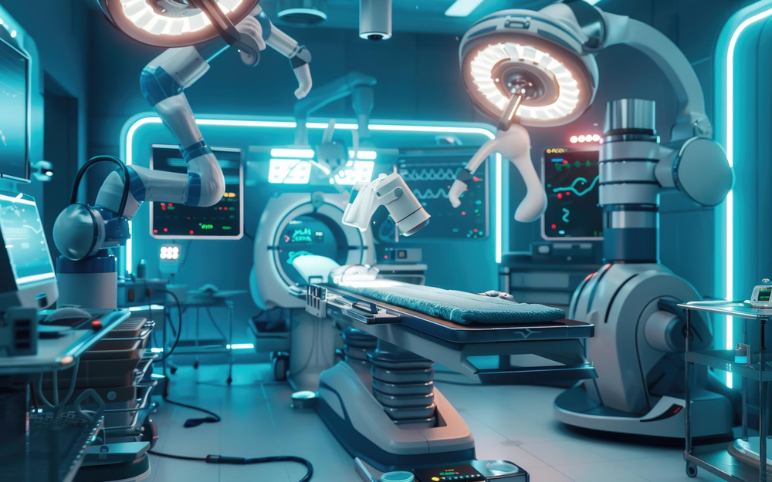The features such as a heads-up 3D monitor, multiple digital display options, and an intuitive interface present in SeeLuma offer excellent visualization, ergonomics, smooth workflow, and an immersive educational experience.
Premium Image Quality Enhances Visualization
SeeLuma allows surgeons to handle complicated surgical procedures in a comparatively easy manner by offering high-quality images relating to the depth of field, color reproduction, contrast, and resolution. With the use of next-generation 3D 55” and 31” 4K monitors, as well as unique digital binoculars, the platform facilitates 3D heads-up surgery. The embedded functions in SeeLuma assist users in better distinguishing anatomical features by allowing them to highlight and enhance anatomical landmarks.
Multiple Digital Display Options Support Ergonomic Positioning
The platform possesses multiple digital display options, enabling surgeons to operate ergonomically. They can view the 55” or 31” 3D 4K monitor straight ahead of them through a C-shaped suspension arm. The digital binoculars are mounted onto a separate suspension arm and allow surgeons to take on an ergonomic posture and work with ease.
Intuitive Interface Facilitates Efficient Workflow
SeeLuma offers a user-friendly UI with extensive settings. Nurses or the operating surgeon themselves can use the foot switch to directly control key system functionality from the on-screen menu. System variables like white balance, image inversion, zoom and focus speeds, and foot control layouts are automatically adjusted to surgical steps. Furthermore, the user interface offers simple, quick access to system capabilities in a manner akin to that of personal computers or cell phones.
Interactive Platform Provides Immersive Educational Experience
All parties involved in the process, both inside and outside the operating room (OR), can take part in it fully through the use of SeeLuma. The system enables trainees and stakeholders to observe and foresee surgical processes as they happen while in the OR and/or at a remote location. Surgeons can concurrently connect numerous wireless displays. Also, the system can be useful to facilitate cooperation and learning during live surgery events. Surgeons can use the platform’s Assist Mode to send and receive real-time support through the touchscreen interface and make annotations or notes on the operative image.
SeeLuma will be introduced in the United States and Western Europe this month, with additional countries to follow.
“As part of our broader mission, Bausch + Lomb aims to provide ophthalmic surgeons around the world with innovative visualization and intraoperative diagnostic technologies that enhance the surgical experience to ultimately help deliver better patient outcomes. The launch of SeeLuma is an important milestone on this journey, as it will serve as one of the key foundations for our future image-guided surgical applications.”
Joe Gordon, president, Global Consumer, Surgical and Vision Care, Bausch + Lomb
“SeeLuma addresses several challenges that many surgeons often struggle with when using surgical microscopes that are currently available. Having access to a platform that offers cutting edge visualization, efficient workflow and ergonomics, and educational features has the potential to really change the landscape and ultimately deliver tremendous benefits for current and future generations of surgeons, as well as their practices and patients.”
Siegfried Priglinger, professor, director, and chairman of, the University Eye Hospital of the Ludwig-Maximilians-Universität, Munich, Germany
According to DelveInsight’s “Ophthalmic Surgical Devices Market” report, the global ophthalmic surgical devices market was valued at USD 8.91 billion in 2021 and will grow at a CAGR of 5.09% during the forecast period from 2022 to 2027 to reach USD 11.97 billion by 2027. The ophthalmic surgical devices market is observing remarkable market growth due to the factors such as the growing prevalence of various ophthalmic disorders such as glaucoma, cataract, refractive errors, and others.
Moreover, the rising burden of the geriatric population, the rising prevalence of diabetes, and other risk factors for ophthalmic disorders will aid in driving the market for ophthalmic surgical devices. Additionally, the rising awareness about vision impairment, surging technological advancements in the devices, the increasing product launches and approvals, the presence of key players in the market, and other factors will create a requisite for ophthalmic surgical devices in the market. Therefore, the market for ophthalmic surgical devices is estimated to grow at a substantial CAGR during the forecast period from 2022 to 2027.
RapidAI Received First and Only FDA 510(k) Clearance of Non-Contrast CT Imaging Product to Accelerate Acute Stroke Triage
On April 18, 2023, RapidAI, the global leader in neurovascular and vascular AI-enhanced clinical decision support and patient workflow received 510(k) clearance by the US Food and Drug Administration for its Rapid NCCT Stroke, becoming the first and only FDA-cleared medical device to detect suspected intracranial hemorrhage (ICH) and large vessel occlusion (LVO) from value-based CT imaging.
Based on artificial intelligence (AI) technology, Rapid NCCT Stroke is used to analyze non-contrast CT (NCCT) images to determine suspicion of ICH and LVO of the distal internal carotid artery (ICA) and middle cerebral artery (MCA-M1). The fully automated system then delivers triage and prioritization notifications through PACS, email, and the Rapid mobile app.
Rapid NCCT Stroke is a major addition to the RapidAI suite of non-contrast-based solutions for stroke and trauma care allowing hospitals and care teams to make time-sensitive workflow and transfer decisions faster.
Rapid NCCT Stroke assist teams in:
- Shortening the time from the door to imaging and the door to the choice
- Making faster transfer decisions
- Improving access to modern, value-based CT imaging technologies, which may enhance decision-making and may have an influence on patient outcomes
“This technology will not only have an enormous impact on stroke care here in the U.S. but also globally by giving care teams at small, local, or regional facilities around the world access to advanced clinical decision support technology too often only available at comprehensive stroke centers. Our hope is that by providing better information early for more informed treatment and transfer decisions, Rapid NCCT Stroke will support faster stroke care and better patient outcomes. This is an incredible achievement for the team and yet another example of RapidAI’s continued leadership in creating the next evolution of stroke care technology.”
Karim Karti, CEO of RapidAI
According to DelveInsight’s “Intracranial Hemorrhage (ICH) Devices Market” report, the global intracranial hemorrhage (ICH) Devices Market was valued at USD 1.59 billion in 2021, growing at a CAGR of 6.65% during the forecast period from 2022 to 2027 to reach USD 2.35 billion by 2027. The increase in demand for intracranial hemorrhage (ICH) devices is primarily attributed to the rising cases of brain disorders such as stroke, cerebral/brain aneurysm, and others. Further, the growing burden of the old age population suffering from brain disorders, and shifting focus towards the development of technologically advanced ICH devices, among others, are thereby contributing to the growth of the intracranial hemorrhage (ICH) devices market during the forecast period from 2022-2027.
First Patients Enrolled in Boomerang Medical Multi-Center Clinical Trial Evaluating Breakthrough Bioelectronic Device for Inflammatory Bowel Disease
On April 17, 2023, Boomerang Medical, a women-led bioelectronic medicine company announced that the first patients were enrolled in the clinical trial meant for evaluating the application of nerve stimulation as a potential treatment for Crohn’s disease and ulcerative colitis, the two most common forms of Inflammatory Bowel Disease (IBD) in the United States.
The trial will examine the safety and performance of the bioelectronic device which already received the breakthrough device designation from the US FDA earlier this year. The device will be used in patients with mild to moderately severe Crohn’s disease and ulcerative colitis, regardless of whether they have previously undergone advanced therapy such as biologics.
The first patient was enrolled in the study in Kansas, followed by Columbia University Irving Medical Center in New York, NY.
“Crohn’s disease and ulcerative colitis remain very difficult to manage, despite the numerous approved biologic therapies available. The Boomerang clinical trial aims to investigate a novel alternative intervention – a device to treat IBD. We are excited to be investigating this promising new treatment.”
Michael Lievens, M.D., principal investigator for the Boomerang trial at Kansas Gastroenterology, LLC. Michael
“The most fascinating aspect of this study is the possibility of managing IBD simply by stimulating the patient’s autonomic system to release anti-inflammatory mediators.”
Marco Zoccali, M.D., FACS, principal investigator for the Boomerang trial at Columbia University Irving Medical Center
“We are thrilled to enroll the first patients in this clinical trial of our breakthrough bioelectronic device for IBD. This trial represents a major milestone in our efforts to develop a new therapeutic approach for patients suffering from Crohn’s disease and ulcerative colitis. We are grateful for the support of our clinical trial partners and the FDA, and we look forward to advancing this important work.”
Heather Simonsen, CEO of Boomerang Medical
As per DelveInsight’s “Inflammatory Bowel Disease Market” report, the global inflammatory bowel disease (IBD) market is estimated to grow at a CAGR of 5.72% during the forecast period from 2022 to 2027. The IBD market is slated to witness prosperity owing to factors such as the rising prevalence of IBD, including Crohn’s Disease (CD) and Ulcerative Colitis (UC), increasing risk factors for IBD, an increasing number of clinical trials for IBD drugs, and the growing focus on improving the safety and usability of IBD drugs and diagnostic devices are further expected to result in the appreciable revenue growth in the IBD market during the forecast period (2022-2027).
Oxford Nanopore and bioMérieux Entered into a Strategic Partnership Agreement to Develop Innovative Infectious Disease Diagnostics
On April 14, 2023, Oxford Nanopore Technologies plc, the company delivering a new generation of nanopore-based molecular sensing technology, and bioMérieux SA, a world leader in the field of in vitro diagnostics, announced that they have teamed up to improve health outcomes globally by exploring selected opportunities to bring nanopore sequencing to the infectious disease diagnostics market.
Nanopore-based sequencing which allows analysis of long DNA or RNA fragments is a novel technology that works by monitoring changes to an electrical current as nucleic acids are passed through a protein nanopore. Thus, to provide the specific DNA or RNA sequence, the resulting signal is decoded.
This technology is ideal for the rapid and cost-effective characterization of microbial pathogens in clinical samples owing to its unique real-time and scalable features.
Oxford Nanopore is uniquely positioned to provide nanopore-based sequencing solutions that provide comprehensive results and shorten the time to results for infectious diseases research and diagnostic applications by offering quick and accurate identification of microbial pathogens and associated antimicrobial resistance.
An assay to identify pathogens in typically sterile clinical samples, a test to determine antibiotic resistance for tuberculosis, and validating Oxford Nanopore’s sequencing platform with BIOMÉRIEUX EPISEQ® CS application for quick infection outbreak monitoring in patient-care settings are the initial areas of collaboration.
“We are pleased to partner with bioMérieux’s IVD expertise to add powerful new tools for the fight against infectious disease. By offering rapid and accurate identification of pathogens and associated antimicrobial resistance, at scale, we hope to better equip the specialists for whom speed and access to comprehensive data is key.”
Gordon Sanghera, Oxford Nanopore Technologies Chief Executive Officer
“We are excited to enter into a research partnership with Oxford Nanopore in the field of infectious diseases. New technologies such as sequencing hold promise to improve diagnostics and patient care; our teams will collaborate in this direction.”
Alexandre Mérieux, bioMérieux Chairman and CEO
According to DelveInsight’s “Infectious Disease Diagnostics Market” report, the global infectious disease diagnostics market was valued at USD 38.52 billion in 2021 and is estimated to grow at a CAGR of 3.80% during the forecast period (2022–2027) to reach USD 48.10 billion by 2027. The infectious disease market is slated to witness prosperity owing to factors such as the growing prevalence of infectious diseases such as COVID-19, malaria, typhoid, and others, rising incidences of epidemics and pandemics, and the growing focus on improving the safety, affordability, and usability of infectious disease diagnostics for end-users are further expected to result in the appreciable revenue growth in the infectious disease diagnostics market during the forecast period (2022-2027).
Neuspera Medical Announced FDA Clearance of Peripheral Nerve Stimulation System
On April 18, 2023, Neuspera Medical, a medical device company developing implantable devices for patients battling chronic illnesses, received the US Food and Drug Administration (FDA) clearance for the next-generation Neuspera ultra-miniaturized system.
Peripheral nerve stimulation (PNS) is delivered through the Neuspera system using a wireless, less intrusive, and more flexible platform than commercially available technologies. It is the first PNS device to provide an ultra-miniaturized alternative, which could improve patient comfort and procedural flexibility.
Along with being 75x smaller than the smallest commercial implantable pulse generator, the Neuspera system provides physicians the opportunity for deeper anatomical targets compared to current technologies available today.
“We look forward to bringing this innovative technology to physicians and patients in the US. The Neuspera ultra-miniaturized system has the potential to revolutionize the way physicians treat patients battling chronic pain while restoring patients’ health and quality of life.”
Steffen Hovard, CEO of Neuspera Medical.
According to DelveInsight’s “Peripheral Nerve Stimulators Market” report, the global peripheral nerve stimulators market is growing at a CAGR of 6.9% during the forecast period from 2022 to 2027. The increase in demand for peripheral nerve stimulators (PNS) is primarily attributed to the increase in the number of patients suffering from nerve injuries, effective technologies in PNS, growing awareness of peripheral nerve stimulators among people, growing demand for chronic pain management therapies, increasing prevalence of diseases which can drive pain, increasing geriatric population, rising of obese population, among others are anticipated to bolster the market growth, thereby contributing to the growth of the peripheral nerve stimulators market during the forecast period from 2022-2027.
Senseonics Announced the First Pediatric Study Participant Insertions in the ENHANCE Clinical Trial
On April 18, 2023, Senseonics Holdings, Inc., a medical technology company focused on the development and manufacturing of long-term, implantable continuous glucose monitoring (CGM) systems for people with diabetes, announced the insertion of the first pediatric study participant with Eversense® 365-day system in the ENHANCE clinical trial which is designed to evaluate the accuracy and safety of the Eversense system for up to one year.
The trial is being held at the AMCR Institute, a clinical research center focused on pre-diabetes, Type 1 Diabetes, type 2 diabetes, and obesity, under the direction of Dr. Timothy Bailey.
In four facilities across the United States, Eversense systems were implanted in more than 165 adult participants. The last patient is anticipated to complete their 365-day visit during the third quarter of 2023, and enrollment for the 365-day sensor configuration was finished in September 2022.
The trial’s data will also be used to support an application for integrated continuous glucose monitoring, or iCGM, designation in 2023. The first pediatric research participants were enrolled in Q2 2023 after an investigational device exemption (IDE) supplement was submitted and approved for the trial’s expansion to include pediatric patients between the ages of 14 and 18.
“It is a priority for Senseonics to extend the benefits of Eversense to the pediatric patient population. Positive results in the trial would support expanding our ability to transform lives in the global diabetes community. The differentiated features of our long-term implantable Eversense system are uniquely suited to benefit pediatrics and enable parents and their children to work together to manage diabetes. Young people would have the ability to remove their transmitters to participate in activities, without having to worry about wasting valuable sensors, and enjoy ring-free vibrating alarms to help manage their sugar levels without attracting unwanted attention to themselves.”
Francine Kaufman, M.D., Chief Medical Officer of Senseonics
“I am excited to be one of the investigators in the ENHANCE Trial and thrilled to be the first to enroll subjects in the pediatric extension.” Bailey added, “In our experience, CGM is an essential tool for all people with diabetes, especially for those who take insulin. We believe having additional accurate, and especially long-term wear, CGM options for our pediatric patients and their families will increase utilization of the technology and improve the quality of their lives.”
Timothy Bailey, M.D., head of AMCR Institute in Escondido, California
According to DelveInsight’s “Blood Glucose Monitoring Systems Market” report, the global blood glucose monitoring systems market was valued at USD 13.06 billion in 2021, growing at a CAGR of 7.72% during the forecast period from 2022 to 2027, to reach USD 20.40 billion by 2027.
The escalating demand for blood glucose monitoring systems is predominantly attributed to the increasing prevalence of diabetes among the population across the globe and the growing burden of the geriatric population who are susceptible to developing hyperglycemia. In addition, the spike in technologically advanced blood glucose monitoring device product launches and government initiatives to raise awareness regarding proper diabetes management, among others are the factors likely to spur the global blood glucose monitoring systems market.



